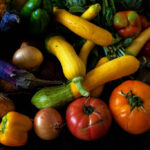Shrimp Francese
 Any dish called “Francese” on an Italian-American menu—and these dishes used to be ubiquitous here—virtually guarantees that the main ingredient will be dipped in egg, and that the sauce will be yellow, not red. But no one is quite sure where this egg-coating tradition came from. Some cite a traditional Neapolitan artichoke dish that gets an eggy coating, but many believe that Italian-American restaurateurs made the dish up in the 1940s to show the fashionable French that they too could prepare delicate food. A few years ago, chef Tom Colicchio, mentioned his theory to me: the technique of dipping the star player in egg is too close to the same process in the dish called “French Toast;” whoever did the naming of dishes “a la Francese,” he opined, “named this egg-coating technique after a breakfast dish with the word ‘French’ in it!” Wherever “Francese” started (France, Italy, or the U.S.), it is a positively delicious treatment for chicken, veal, pork, and—perhaps my favorite Francesed protein—shrimp.
Any dish called “Francese” on an Italian-American menu—and these dishes used to be ubiquitous here—virtually guarantees that the main ingredient will be dipped in egg, and that the sauce will be yellow, not red. But no one is quite sure where this egg-coating tradition came from. Some cite a traditional Neapolitan artichoke dish that gets an eggy coating, but many believe that Italian-American restaurateurs made the dish up in the 1940s to show the fashionable French that they too could prepare delicate food. A few years ago, chef Tom Colicchio, mentioned his theory to me: the technique of dipping the star player in egg is too close to the same process in the dish called “French Toast;” whoever did the naming of dishes “a la Francese,” he opined, “named this egg-coating technique after a breakfast dish with the word ‘French’ in it!” Wherever “Francese” started (France, Italy, or the U.S.), it is a positively delicious treatment for chicken, veal, pork, and—perhaps my favorite Francesed protein—shrimp.
SERVES 2
10 large shrimp (about ½ lb)
¼ teaspoon kosher salt
2 jumbo eggs, beaten well
¼ cup finely grated Pecorino Romano
Flour for dredging
¼ cup olive oil
¼ cup dry white wine
1 cup chicken stock, heated in a saucepan
6 thin, round slices of lemon, seeds removed
2 tablespoons butter
2 tablespoons finely minced parsley for garnish
1. Peel the shrimp completely. Split each one down the back, running your knife almost through to the other side. Remove black vein. Spread out each shrimp, butterfly-fashion, so it sits flat on the counter. Sprinkle shrimp with salt, front and back, and let rest for a few minutes.
2. Place the eggs in a wide, shallow bowl. Add the Pecorino Romano. Mix well. Place flour for dredging in another wide, shallow bowl.
3. When ready to cook, divide the ¼ cup olive oil among 2 medium-sized sauté pans over medium heat. Quickly coat the shrimp: dip each one in the egg-cheese mixture, let excess drip off, then dip lightly in flour. Place each shrimp as it’s coated in the hot oil, working up to 5 shrimp per pan. Cook the shrimp, turning once or twice, until they are golden on the outside, just-cooked on the inside (about 1-2 minutes per side). When the shrimp are done, remove from pans and keep warm.
4. Spill oil out of the sauté pans. Immediately place 2 tablespoons of wine in each pan, raise the heat to high, and reduce the wine to 1 tablespoon in each pan. Divide the heated stock and the lemon slices between the 2 pans. Boil for 5 minutes, then remove the lemon slices. Keep boiling the sauce (another moment or two), until it’s reduced in each pan to ¼ cup. Turn the heat to very low. Swirl a tablespoon of butter into each pan until the sauce is thickened. Taste for seasoning.
5. Add 5 reserved shrimp to each pan, turning the shrimp until they’re coated with the sauce. Divide the shrimp between 2 dinner plates, pour the remaining sauce over them, sprinkle with parsley, and serve immediately.
And the wine…
2014 Vignevive Pecorino Terre di Chiete IGT
 Pecorino is the scintillating everyday white of Abruzzo, a great eating region. NOTE: it has nothing to do with cheese! Light straw in the glass. Neutral nose, notable for its lack of cheap-smelling fruit! Wonderful acidity, with a lovely touch of astringency for backbone. Finishes clean and lemony. A great wine for food—perfect risotto wine, plus an excellent wine for light pasta dishes, simple shellfish dishes, grilled fish with olive oil.
Pecorino is the scintillating everyday white of Abruzzo, a great eating region. NOTE: it has nothing to do with cheese! Light straw in the glass. Neutral nose, notable for its lack of cheap-smelling fruit! Wonderful acidity, with a lovely touch of astringency for backbone. Finishes clean and lemony. A great wine for food—perfect risotto wine, plus an excellent wine for light pasta dishes, simple shellfish dishes, grilled fish with olive oil.



